
A crozier or crosier is a stylized staff that is a symbol of the governing office of a bishop or abbot and is carried by high-ranking prelates of Roman Catholic, Eastern Catholic, Eastern Orthodox, Oriental Orthodox, Malankara Mar Thoma Syrian Church, and some Anglican, Lutheran, United Methodist and Pentecostal churches.

The Stowe Missal, which is, strictly speaking, a sacramentary rather than a missal, is a small Irish illuminated manuscript written mainly in Latin with some Old Irish in the late eighth or early ninth century, probably after 792. In the mid-11th century, it was annotated and some pages rewritten at Lorrha Monastery in County Tipperary, Ireland. Between 1026 and 1033 the manuscript was encased within a protective cumdach, which was refurbished and embellished a number of times in the late medieval period, in particular before 1381, the year of death of Pilib O'Ceinneidigh, Lord of Ormond, who then had possession of the shrine.
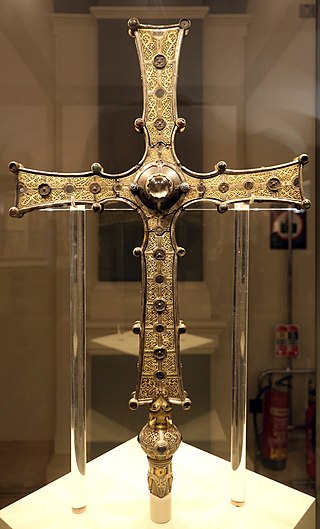
The Cross of Cong is an early 12th-century Irish Christian ornamented cusped processional cross, which was, as an inscription says, made for Tairrdelbach Ua Conchobair, King of Connacht and High King of Ireland to donate to the Cathedral church of the period that was located at Tuam, County Galway, Ireland. The cross was subsequently moved to Cong Abbey at Cong, County Mayo, from which it takes its name.

The National Museum of Ireland – Archaeology is a branch of the National Museum of Ireland located on Kildare Street in Dublin, Ireland, that specialises in Irish and other antiquities dating from the Stone Age to the Late Middle Ages.

The Kells crozier or British Museum Crozier is an early medieval Irish Insular crozier. It is often known as the "Kells Crozier", indicating an associating with the Abbey of Kells, although no evidence of this exists, and most historians accept that it is of uncertain providence. The crozier is fully intact, although some of the ornamentation is in poor condition.

The Bell Shrine of St. Cuileáin is a late-11th or early-12th century bell shrine found in the early modern period hidden in a tree in Glenkeen, near Borrisoleigh in County Tipperary, Ireland. It was built to hold a 7th-century iron hand bell thought to have been owned by St. Cuileáin; the name "Bearnán Chúláin" translates from Irish as the "gapped [one or bell] of Cúlán".

The Domnach Airgid is an 8th-century Irish wooden reliquary. It was considerably reworked between the 13th and 15th centuries and became a cumdach or "book shrine", when its basic timber structure was reinforced and decorated by elaborate silver-gilt metalwork. Its front cover was enhanced by gilded relief showing Jesus in "Arma Christi", alongside depictions of saints, angels, and clerics, in scenes imbued with complex iconography. It is thus considered a mixture of the early Insular and later International Gothic styles.

The Soiscél Molaisse is an Irish cumdach that originated from an 8th-century wooden core embellished in the 11th and 15th centuries with metal plates decorated in the Insular style. Until the late 18th century, the shrine held a now-lost companion text, presumed to be a small illuminated gospel book associated with Saint Laisrén mac Nad Froích, also known as Molaisse or "Mo Laisse". In the 6th century, Molaisse founded a church on Devenish Island in the southern part of Lough Erne in County Fermanagh, with which the cumdach is associated.

House-shaped shrine are early medieval portable metal reliquary formed in the shape of the roof of a rectangular building. They originate from both Ireland and Scotland and mostly date from the 8th or 9th centuries. Typical example consist of a wooden core covered with silver and copper alloy plates, and were built to hold relics of saints or martyrs from the early Church era; a number held corporeal remains when found in the modern period, presumably they were parts of the saint's body. Others, including the Breac Maodhóg, held manuscripts associated with the commemorated saint. Like many Insular shrines, they were heavily reworked and embellished in the centuries following their initial construction, often with metal adornments or figures influenced by Romanesque sculpture.

The Shrine of Saint Lachtin's Arm is an early 10th-century Irish arm-shrine type reliquary made of wood and metal shaped as an outstretched forearm and clenched fist. St. Lachtin's dates to between 1118 and 1121 and is associated with his church in the village of Stuake, Donoughmore, County Cork, but probably originates from Kilnamartyra, also in Cork. It consists of a yew-wood core lined with decorated bronze and silver plates. The wood at the hand is hollowed out to create a reliquary cavity which once held the arm bone of St. Lachtin, but is now empty. The circular cap at its base contains a large transparent gemstone and is inlayed with silver decorated with filigree.
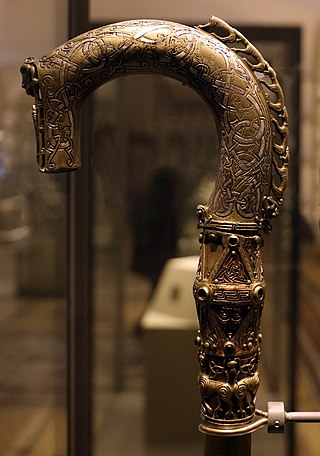
An Insular crozier is a type of processional bishop's staff (crozier) produced in Ireland and Scotland between 800 and 1200. Such items can be distinguished from mainland European types by their curved and open crooks, and drop. By the end of the 12th century, production of Irish croziers had largely ended, but examples continued to be reworked and added to throughout the Romanesque and Gothic periods. Although many of the croziers are associated with 5th- and 6th-century saints, the objects were not made until long after the saints had died. A majority originate from around the 9th century, with a number further embellished between the 11th and 13th centuries.

The Clonmacnoise Crozier is a late-11th-century Insular crozier that would have been used as a ceremonial staff for bishops and mitred abbots. Its origins and medieval provenance are unknown. It was likely discovered in the late 18th or early 19th century in the monastery of Clonmacnoise in County Offaly, Ireland. The crozier has two main parts: a long shaft and a curved crook. Its style reflects elements of Viking art, especially the snake-like animals in figure-of-eight patterns running on the sides of the body of the crook, and the ribbon of dog-like animals in openwork that form the crest at its top. Apart from a shortening to the staff length and the loss of some inserted gems, it is largely intact and is one of the best-preserved surviving pieces of Insular metalwork.
Griffin Murray is an Irish archaeologist and art historian specialising in medieval Ireland and Insular art–especially metalwork–in the period between 400–1550 AD. His interests include identifying and contextualizing the social role of medieval craftsmen, Viking art and the relations between insular and Scandinavian craftsmen, and he is a leading expert on both house-shaped shrines and insular croziers.

The Lismore Crozier is an Irish Insular-type crozier dated to between 1100 and 1113 AD. It consists of a wooden tubular staff lined with copper-alloy plates; embellished with silver, gold, niello and glass; and capped by a crook with a decorative openwork crest. The inscriptions on the upper knope record that it was built by "Nechtain the craftsman" and commissioned by Niall mac Meic Aeducain, bishop of Lismore. This makes it the only extant insular crozier to be inscribed, and the only one whose date of origin can be closely approximated. It was rediscovered in 1814, along with the 15th-century Book of Lismore, in a walled-up doorway in Lismore Castle, County Waterford, where it was probably hidden in the late Middle Ages during a period of either religious persecution or raids.
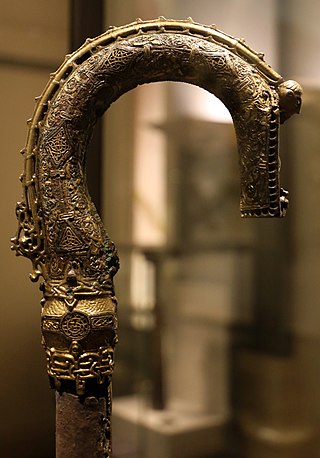
The River Laune Crozier is a late 11th-century Insular crozier, now at the Archaeology branch of the National Museum of Ireland. The object would have been commissioned as a staff of office for a senior clergyman, most likely a bishop. It consists of a wooden core decorated with fitted bronze and silver metal plates. Although the metalwork is somewhat corroded in parts, it is fully intact and considered one of the finest surviving Irish examples, alongside those found at Clonmacnoise and Lismore.
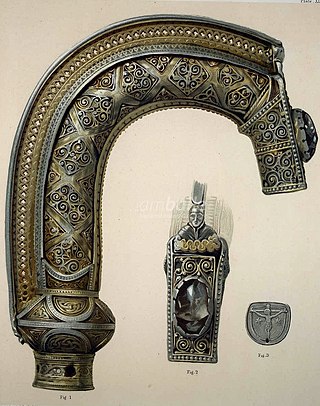
St. Fillan's Crozier is an 8th century Insular crozier crook traditionally associated with the Irish monk St. Fillan, who lived in the eighth century at Glendochart in Perthshire, central Scotland. Only the crook survives; the staff was lost at an unknown date. Sometime around the late 13th century it was encased in the Coigreach, a crosier-shrine of similar size and form built as a protective case, made from silver, gold and rock crystal and dating from the late 13th century, with additions c. the 14th or 15th centuries. The Coigreach was rediscovered in the mid-19th century by the archaeologist Daniel Wilson, who opened it and found St. Fillan's Crozier inside.
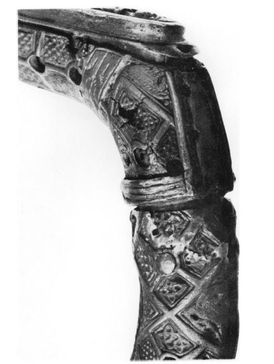
St. Mel's Crozier was a fully intact 10th or 11th century Insular crozier discovered in the mid-19th century on the grounds of an early medieval church in Ardagh, County Longford. It consisted of a wooden core lined with metal sheet tubing decorated with silver, coral and glass, as well as three knopes and a ring towards its base. The drop plate was formed by a separately formed wood block, which was added to in the 12th century with a figure of a cleric or bishop wearing a mitre and holding a staff.

St. Columba's Crozer is a fragment of an 8th or 9th century Irish Insular crozier fragment. It consists of a wooden core covered by sheet bronze tubes decorated with a bronze knope lined with silver and gilt. The wooden shaft measures four feet and is elaborately decorated but incomplete: it was found broken in two, and both its foot and crook are missing.
Cormac Bourke is an Irish archeologist specialising in Medieval studies, early church history and insular Christianity. He is a former, long term, curator of Medieval Antiquities at the Ulster Museum, Belfast, and currently works at the antiquities department of the National Museum of Ireland.

The Shrine of St Patrick's Tooth is a medieval reliquary traditionally believed to contain a tooth belonging to Patrick, Ireland's patron saint, who lived in the 5th century. The shrine comprises a wooden case lined with bronze and decorated with gold, silver and amber fittings, and was built in two phases. Its basic structure and the central ringed crosses on either side are 12th century, while the purse-shaped form and most of the metal work, including the saints, were added in the 1370s when the object was substantially refurbished.





















